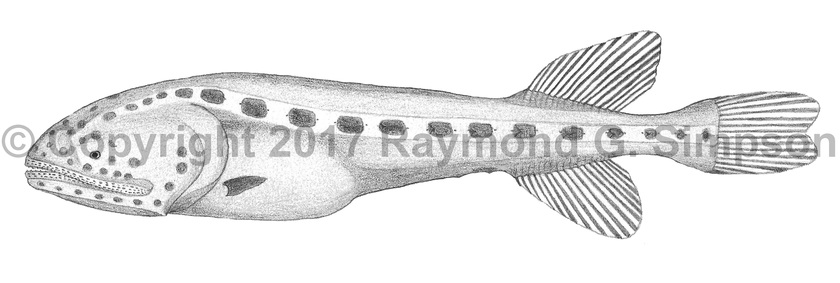
Common Name
Myer's Whalefish
Year Described
Parr, 1934
Identification
Dorsal Fin: 16-17
Anal Fin: 17-18
Pectoral Fin: 18-19
Lateral Line Pores: 15-16
Gill Arches: 3
Vertebrae:
Genus diagnosis after Paxton (1989) for females:
Dorsal fin base 14.5-17.6% SL. Head length 28-32% SL. Body rather elongated with a huge mouth (third of body length). Snout rounded. Head wider than body. Eye tiny. Nasal organ small. Jaws slightly convex to straight on upper but concave on lower. Three distinct gill arches with a small slit behind it. Gill tooth plates contiguous. Lateral line conspicuous with large round pores inside a channel with raised rim. Lateral pores can have dermal flaps (in G. myersi_) or not (_G. simplex). No vertical rows of papillae on lateral line. Lateral line system continues onto head as a series of pores and sensory openings. Additional pores on lower jaw and snout. Jaw teeth relatively long (three times longer than wide) in regular or irregular rows. Vomerine tooth patch rectangular or flat. Dorsal and anal fins located far back on body, with bases slightly elevated. Cavernous tissue located around the anus and anal fin base. None elsewhere on body Caudal fin with less than 17 principle rays. Pelvic fin absent. Pectoral fin small and inserted low on body. Body flabby and scaleless except for large, diagnostic scales associated with the lateral line canals.
Males and juveniles unknown.
Color
Fresh specimen stated to be chocolate brown with darker finrays. Interior of mouth bright red with red pigment along fin bases.
Size
Maximum size to 66mm SL.
Habitat
Taken in the Gulf of Mexico at about 1200m and off Bermuda between 1300-1700m.
Range
Widely distributed from Greenland to off the northeastern U.S. (Moore et al., 2003), off Bermuda (Harry, 1952), the Bahamas (Parr, 1934), and the Gulf of Mexico (Parr, 1946).
References
Harry, R.R. 1952. Deep-sea fishes of the Bermuda oceanographic expeditions. Families Cetomimidae and Rondeletiidae. Zoologica, Scientific Contributions of the New York Zoological Society v. 37 (pt 1, no. 5): 55-72, Pl. 1.
Parr, A.E. 1934. Report on experimental use of a triangular trawl for bathypelagic collecting with an account of the fishes obtained and a revision of the family Cetomimidae. Bulletin of the Bingham Oceanographic Collection Yale University v. 4 (art. 6): 1-59.
Parr, A.E. 1946. A new species of Gyrinomimus from the Gulf of Mexico. Copeia 1946 (no. 3): 116-117, Pl. 1.
Paxton, J.R. 1989. Synopsis of the whalefishes (family Cetomimidae) with descriptions of four new genera. Records of the Australian Museum v. 41: 135-206.
Rofen, R.R. 1959. The whale-fishes: families Cetomimidae, Barbourisiidae and Rondeletiidae. (Order Cetunculi). Galathea Report v. 1: 255-260, Plates 1-2.
Other Notes
Gyrinomimus simplex is tentatively considered a junior synonym of this species (Catalog of Fishes). Parr (1946) stated that G. simplex differed in tooth pattern, head size, and presence of dermal flaps on pores. The taxonomy of the complex of species including Gyrinomimus myersi, G. simplex, and G. parri needs to be investigated further as there are few adult specimens, condition is poor, and variation is not understood in some of the characters used for identification. Gyrinomimus parri is kept separate for now due to it’s very long dorsal fin base which is much larger (24% SL) than Gyrinomimus myersi/simplex (<18% SL).